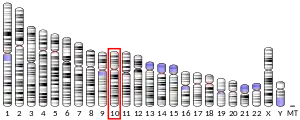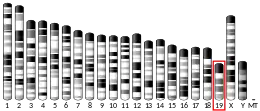The solute carrier family 18 member 2 (SLC18A2) also known as vesicular monoamine transporter 2 (VMAT2) is a protein that in humans is encoded by the SLC18A2 gene.[5] SLC18A2 is an integral membrane protein that transports monoamines—particularly neurotransmitters such as dopamine, norepinephrine, serotonin, and histamine—from cellular cytosol into synaptic vesicles.[6] In nigrostriatal pathway and mesolimbic pathway dopamine-releasing neurons, SLC18A2 function is also necessary for the vesicular release of the neurotransmitter GABA.[7]
Binding sites and ligands
SLC18A2 is believed to possess at least two distinct binding sites, which are characterized by tetrabenazine (TBZ) and reserpine binding to the transporter.[8] Amphetamine (TBZ site) and methamphetamine (reserpine site) bind at distinct sites on SLC18A2 to inhibit its function.[8] SLC18A2 inhibitors like tetrabenazine and reserpine reduce the concentration of monoamine neurotransmitters in the synaptic cleft by inhibiting uptake through SLC18A2; the inhibition of SLC18A2 uptake by these drugs prevents the storage of neurotransmitters in synaptic vesicles and reduces the quantity of neurotransmitters that are released through exocytosis. Although many substituted amphetamines induce the release of neurotransmitters from vesicles through SLC18A2 while inhibiting uptake through SLC18A2, they may facilitate the release of monoamine neurotransmitters into the synaptic cleft by simultaneously reversing the direction of transport through the primary plasma membrane transport proteins for monoamines (i.e., the dopamine transporter, norepinephrine transporter, and serotonin transporter) in monoamine neurons. Other SLC18A2 inhibitors such as GZ-793A inhibit the reinforcing effects of methamphetamine, but without producing stimulant or reinforcing effects themselves.[9]
Researchers have found that inhibiting the dopamine transporter (but not SLC18A2) will block the effects of amphetamine and cocaine; while, in another experiment, observing that disabling SLC18A2 (but not the dopamine transporter) prevents any notable action in test animals after amphetamine administration yet not cocaine administration. This suggests that amphetamine may be an atypical substrate with little to no ability to prevent dopamine reuptake via binding to the dopamine transporter but, instead, uses it to enter a neuron where it then interacts with SLC18A2 to induce efflux of dopamine from their vesicles into the cytoplasm whereupon dopamine transporters with amphetamine substrates attached move this recently liberated dopamine into the synaptic cleft.[10]
Inhibition
SLC18A2 is essential for enabling the release of neurotransmitters from the axon terminals of monoamine neurons into the synaptic cleft. If SLC18A2 function is inhibited or compromised, monoamine neurotransmitters such as dopamine cannot be released into the synapse via typical release mechanisms (i.e., exocytosis resulting from action potentials).
Cocaine users display a marked reduction in SLC18A2 immunoreactivity. Those with cocaine-induced mood disorders displayed a significant loss of SLC18A2 immunoreactivity; this might reflect damage to dopamine axon terminals in the striatum. These neuronal changes could play a role in causing disordered mood and motivational processes in more severely addicted users.[11]
In popular culture
Geneticist Dean Hamer has suggested that a particular allele of the SLC18A2 gene correlates with spirituality using data from a smoking survey, which included questions intended to measure "self-transcendence". Hamer performed the spirituality study on the side, independently of the National Cancer Institute smoking study. His findings were published in the mass-market book The God Gene: How Faith Is Hard-Wired into Our Genes.[12][13] Hamer himself notes that SLC18A2 plays at most a minor role in influencing spirituality.[14] Furthermore, Hamer's claim that the SLC18A2 gene contributes to spirituality is controversial.[14] Hamer's study has not been published in a peer-reviewed journal and a reanalysis of the correlation demonstrates that it is not statistically significant.[14][15]
References
- 1 2 3 GRCh38: Ensembl release 89: ENSG00000165646 - Ensembl, May 2017
- 1 2 3 GRCm38: Ensembl release 89: ENSMUSG00000025094 - Ensembl, May 2017
- ↑ "Human PubMed Reference:". National Center for Biotechnology Information, U.S. National Library of Medicine.
- ↑ "Mouse PubMed Reference:". National Center for Biotechnology Information, U.S. National Library of Medicine.
- ↑ Surratt CK, Persico AM, Yang XD, Edgar SR, Bird GS, Hawkins AL, Griffin CA, Li X, Jabs EW, Uhl GR (March 1993). "A human synaptic vesicle monoamine transporter cDNA predicts posttranslational modifications, reveals chromosome 10 gene localization and identifies TaqI RFLPs". FEBS Lett. 318 (3): 325–30. doi:10.1016/0014-5793(93)80539-7. PMID 8095030. S2CID 8062412.
- ↑ Eiden LE, Schäfer MK, Weihe E, Schütz B (February 2004). "The vesicular amine transporter family (SLC18): amine/proton antiporters required for vesicular accumulation and regulated exocytotic secretion of monoamines and acetylcholine". Pflügers Arch. 447 (5): 636–40. doi:10.1007/s00424-003-1100-5. PMID 12827358. S2CID 20764857.
- ↑ Tritsch NX, Ding JB, Sabatini BL (2012). "Dopaminergic neurons inhibit striatal output through non-canonical release of GABA". Nature. 490 (7419): 262–6. Bibcode:2012Natur.490..262T. doi:10.1038/nature11466. PMC 3944587. PMID 23034651.
- 1 2 Sulzer D, Sonders MS, Poulsen NW, Galli A (April 2005). "Mechanisms of neurotransmitter release by amphetamines: a review". Prog. Neurobiol. 75 (6): 406–33. doi:10.1016/j.pneurobio.2005.04.003. PMID 15955613. S2CID 2359509.
They also demonstrated competition for binding between METH and reserpine, suggesting they might bind to the same site on VMAT. George Uhl's laboratory similarly reported that AMPH displaced the VMAT2 blocker tetrabenazine (Gonzalez et al., 1994). Tetrabenazine and reserpine are thought to bind to different sites on VMAT (Schuldiner et al., 1993a)
- ↑ Alvers KM, Beckmann JS, Zheng G, Crooks PA, Dwoskin LP, Bardo MT (2012). "The effect of VMAT2 inhibitor GZ-793A on the reinstatement of methamphetamine-seeking in rats". Psychopharmacology. 224 (2): 255–62. doi:10.1007/s00213-012-2748-3. PMC 3680349. PMID 22638813.
- ↑ Freyberg, Z.; Sonders, M.; Aguilar e al., M. (16 February 2016). "Mechanisms of amphetamine action illuminated through optical monitoring of dopamine synaptic vesicles in Drosophila brain". Nature Communications. 7: 10652. Bibcode:2016NatCo...710652F. doi:10.1038/ncomms10652. PMC 4757768. PMID 26879809.
- ↑ Little KY, Krolewski DM, Zhang L, Cassin BJ (January 2003). "Loss of striatal vesicular monoamine transporter protein (VMAT2) in human cocaine users". Am J Psychiatry. 160 (1): 47–55. doi:10.1176/appi.ajp.160.1.47. PMID 12505801.
- ↑ Hamer DH (2004). The God gene: how faith is hardwired into our genes. Garden City, N.Y: Doubleday. ISBN 0-385-50058-0.
- ↑ Kluger J, Chu J, Liston B, Sieger M, Williams D (25 October 2004). "Is God in our genes?". TIME. Time Inc. Archived from the original on 30 September 2007. Retrieved 8 April 2007.
- 1 2 3 Silveira LA (2008). "Experimenting with spirituality: analyzing The God Gene in a nonmajors laboratory course". CBE: Life Sciences Education. 7 (1): 132–45. doi:10.1187/cbe.07-05-0029. PMC 2262126. PMID 18316816.
- ↑ Zimmer C (October 2004). "Faith-Boosting Genes: A search for the genetic basis of spirituality". Scientific American. doi:10.1038/scientificamerican1004-110.
Further reading
- Need AC, Keefe RS, Ge D, Grossman I, Dickson S, McEvoy JP, Goldstein DB (2009). "Pharmacogenetics of antipsychotic response in the CATIE trial: a candidate gene analysis". Eur. J. Hum. Genet. 17 (7): 946–57. doi:10.1038/ejhg.2008.264. PMC 2986499. PMID 19156168.
- Okamura N, Villemagne VL, Drago J, Pejoska S, Dhamija RK, Mulligan RS, Ellis JR, Ackermann U, O'Keefe G, Jones G, Kung HF, Pontecorvo MJ, Skovronsky D, Rowe CC (2010). "In vivo measurement of vesicular monoamine transporter type 2 density in Parkinson disease with (18)F-AV-133". J. Nucl. Med. 51 (2): 223–8. doi:10.2967/jnumed.109.070094. PMID 20080893.
- Saisho Y, Harris PE, Butler AE, Galasso R, Gurlo T, Rizza RA, Butler PC (2008). "Relationship between pancreatic vesicular monoamine transporter 2 (VMAT2) and insulin expression in human pancreas". J. Mol. Histol. 39 (5): 543–51. doi:10.1007/s10735-008-9195-9. PMC 2566800. PMID 18791800.
- Tsolakis AV, Grimelius L, Stridsberg M, Falkmer SE, Waldum HL, Saras J, Janson ET (2009). "Obestatin/ghrelin cells in normal mucosa and endocrine tumours of the stomach". Eur. J. Endocrinol. 160 (6): 941–9. doi:10.1530/EJE-09-0001. PMID 19289536.
- Harris PE, Ferrara C, Barba P, Polito T, Freeby M, Maffei A (2008). "VMAT2 gene expression and function as it applies to imaging beta-cell mass". J. Mol. Med. 86 (1): 5–16. doi:10.1007/s00109-007-0242-x. PMID 17665159. S2CID 20374043.
- Roe BE, Tilley MR, Gu HH, Beversdorf DQ, Sadee W, Haab TC, Papp AC (2009). "Financial and psychological risk attitudes associated with two single nucleotide polymorphisms in the nicotine receptor (CHRNA4) gene". PLOS ONE. 4 (8): e6704. Bibcode:2009PLoSO...4.6704R. doi:10.1371/journal.pone.0006704. PMC 2724734. PMID 19693267.
- Sørensen KD, Wild PJ, Mortezavi A, Adolf K, Tørring N, Heebøll S, Ulhøi BP, Ottosen P, Sulser T, Hermanns T, Moch H, Borre M, Ørntoft TF, Dyrskjøt L (2009). "Genetic and epigenetic SLC18A2 silencing in prostate cancer is an independent adverse predictor of biochemical recurrence after radical prostatectomy". Clin. Cancer Res. 15 (4): 1400–10. doi:10.1158/1078-0432.CCR-08-2268. PMID 19228741.
- Watabe M, Nakaki T (2008). "Mitochondrial complex I inhibitor rotenone inhibits and redistributes vesicular monoamine transporter 2 via nitration in human dopaminergic SH-SY5Y cells". Mol. Pharmacol. 74 (4): 933–40. doi:10.1124/mol.108.048546. PMID 18599602. S2CID 1844073.
- Catlow K, Ashurst HL, Varro A, Dimaline R (2007). "Identification of a gastrin response element in the vesicular monoamine transporter type 2 promoter and requirement of 20 S proteasome subunits for transcriptional activity". J. Biol. Chem. 282 (23): 17069–77. doi:10.1074/jbc.M611421200. PMID 17442673.
- Yosifova A, Mushiroda T, Stoianov D, Vazharova R, Dimova I, Karachanak S, Zaharieva I, Milanova V, Madjirova N, Gerdjikov I, Tolev T, Velkova S, Kirov G, Owen MJ, O'Donovan MC, Toncheva D, Nakamura Y (2009). "Case-control association study of 65 candidate genes revealed a possible association of a SNP of HTR5A to be a factor susceptible to bipolar disease in Bulgarian population". J Affect Disord. 117 (1–2): 87–97. doi:10.1016/j.jad.2008.12.021. PMID 19328558.
- Tabakoff B, Saba L, Printz M, Flodman P, Hodgkinson C, Goldman D, Koob G, Richardson HN, Kechris K, Bell RL, Hübner N, Heinig M, Pravenec M, Mangion J, Legault L, Dongier M, Conigrave KM, Whitfield JB, Saunders J, Grant B, Hoffman PL (2009). "Genetical genomic determinants of alcohol consumption in rats and humans". BMC Biol. 7: 70. doi:10.1186/1741-7007-7-70. PMC 2777866. PMID 19874574.
- Zheng G, Dwoskin LP, Crooks PA (2006). "Vesicular monoamine transporter 2: role as a novel target for drug development". AAPS J. 8 (4): E682-92. doi:10.1208/aapsj080478. PMC 2751365. PMID 17233532.
- Crowley JJ, Lipsky RH, Lucki I, Berrettini WH (2008). "Variation in the genes encoding vesicular monoamine transporter 2 and beta-1 adrenergic receptor and antidepressant treatment outcome". Psychiatr. Genet. 18 (5): 248–51. doi:10.1097/YPG.0b013e3283052ff7. PMID 18797399. S2CID 206148319.
- Guo JT, Chen AQ, Kong Q, Zhu H, Ma CM, Qin C (2008). "Inhibition of vesicular monoamine transporter-2 activity in alpha-synuclein stably transfected SH-SY5Y cells". Cell. Mol. Neurobiol. 28 (1): 35–47. doi:10.1007/s10571-007-9227-0. PMID 17985233. S2CID 20230170.
- Talkowski ME, Kirov G, Bamne M, Georgieva L, Torres G, Mansour H, Chowdari KV, Milanova V, Wood J, McClain L, Prasad K, Shirts B, Zhang J, O'Donovan MC, Owen MJ, Devlin B, Nimgaonkar VL (2008). "A network of dopaminergic gene variations implicated as risk factors for schizophrenia". Hum. Mol. Genet. 17 (5): 747–58. doi:10.1093/hmg/ddm347. PMC 3777405. PMID 18045777.
- Verney C, Lebrand C, Gaspar P (2002). "Changing distribution of monoaminergic markers in the developing human cerebral cortex with special emphasis on the serotonin transporter". Anat. Rec. 267 (2): 87–93. doi:10.1002/ar.10089. PMID 11997877. S2CID 2088307.
- Perlis RH, Moorjani P, Fagerness J, Purcell S, Trivedi MH, Fava M, Rush AJ, Smoller JW (2008). "Pharmacogenetic analysis of genes implicated in rodent models of antidepressant response: association of TREK1 and treatment resistance in the STAR(*)D study". Neuropsychopharmacology. 33 (12): 2810–9. doi:10.1038/npp.2008.6. PMC 10034848. PMID 18288090.
- Caudle WM, Richardson JR, Wang MZ, Taylor TN, Guillot TS, McCormack AL, Colebrooke RE, Di Monte DA, Emson PC, Miller GW (2007). "Reduced vesicular storage of dopamine causes progressive nigrostriatal neurodegeneration". J. Neurosci. 27 (30): 8138–48. doi:10.1523/JNEUROSCI.0319-07.2007. PMC 6672727. PMID 17652604.
External links
- Vesicular+Monoamine+Transporter+2 at the U.S. National Library of Medicine Medical Subject Headings (MeSH)



